Chapter 3 - the problem obsolescences.
In order to understand the problem of the obsolescence of the members and to interpret of the consequences, it is necessary to analyze the change of problematic the relative ones to the trend of market of the last ones trenta-quarant'anni.
Like saying in the previous paragraphs, whichever item can be affection from DMSMD, but, being such mainly obvious phenomenon for the electronic devices, it is well to stop the attention on dynamics that has interested this market: the industry electronic, in fact, is one of the more dynamic fields of the world-wide industry; in order to understand this truth enough to think that, in the United States, such field has been developed, from 1990 to 2000, with a greater rate of growth three times to that relative one to the other markets.
This fast increase therefore, has carried dramatic consequences in the world of the devices electronic you: changes like the feeding voltage, the reduction of I block it or the increase in the execution speed, is by now events that take place with cadence nearly salary.
Such tendency has caused a drastic reduction of the cycle of life of the members of this merceologica class, in how much, in order to remain competitive you in a dynamic market therefore and characterized from a so fast increase, the producers have been looked at forced to change just continuously output, following dictate me of the new emergent technologies; extreme consequence of this phenomenon, is that the electronic parts, that they compose a destined system complex to a long operating life, remarkablly more short have a cycle of life of the product that compose. A qualitative example of said how much is illustrated in the successive figure.
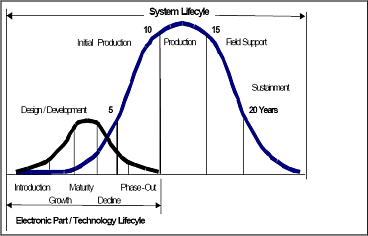
Figure 3.1: Inequality between the length of the cycle of life of a complex system and that one of the members who the costituiscono.3
It has been estimated, to new evidence of how much said, that the production of integrated circuits (IC) has endured, in 1998, a turn over in the technologies used of 34.000 (one medium of 153 warnings of dismissione to day) 4.
In the successive table, to ulterior example, there is an esteem of the medium rate introduction of new generations of integrated circuits on the market.
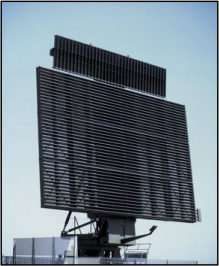
Table 3.1: Medium rate introduction of new generations of integrated circuits on the mercato.5
Therefore, one of first driver that they lead to the state of obsolescence, is just the profit, for the manifacturing company, than it can be gained from the production of an item using, to its inside, one technology rather than with the other oldest one: when the production of a member is not more economically convenient, as mentioned above pointed out, the productive line to dedicated it comes dismessa and adapted to the fabrication of dispositi to you more profitable.
Only in this way, the manifacturing industries of the field, can maintain just the power competitive, unavoidablly to discapito of who, sure the minority of a market much immense one, need of members old style.
Siccome the first and more plentiful applications than such dispositi to you have interested the production of paramilitary weapon systems and, are useful to analyze, moreover as they are changed, in the years, the necessities of these merceologici fields and the supplying relati ones to you: the US Air Force has been, in fact, one of the first organizations to adopt the technology of the integrated circuits when in 1961 it chose to use computers that mounted chip of silicone.
In years sixty and seventy, the Department of the Defense American and divennero NASA the greater world-wide consumers of electronic members and this gave it faculties to they to control of the market, imposing specific and characteristic of the devices you.
What it has happened later on, obviously, resumes the row of the carried speech ahead fin'ora, even if the motivations and the scene are little different ones.
Meaningful for the understanding of the events, the following affirmations could be useful: “During the 1970s, military requirements drove nearly all cutting-edge electronics research and development, and the military purchased about 35 percent of the industry's output of semiconductor components.
By 1984, the military was purchasing only 7 percent of the total domestic semiconductor output.
But in spite of the reduced market to share, military business was still desirable, The military still bought the most advanced and profitable Chips and components, I know most vendors continued to supply the military.
It was at this Time, however, that the momentum began building to redesign military acquisition processes, in part to capitalise more effectively on the rapid developments in commercial electronics.
This well-intentioned movement ultimately failed to anticipated the fallout from the electronic industry's explosive growth, which would significantly change the ground rules for manufacturers.
By the late 1990s, military purchasers confronted to commercial electronic base that was expanding exponentially.
Yet to there was to lag in the understanding of how commercial growth would affect the manufacture of electronics at the component level.
By 2000 and future, the infrastructure available to support military electronics needs has eroded, the military is counting on legacy systems designed in the 1970s and 1980s to servants well the new century.
Active The US Army's current roster of tanks and fighting vehicle is expected to be until 2030, while the US Air Force expects to use its current bomber fleet until 2040.
These The sever obsolescence problems experienced by aging systems can't be fixed by simple component replacement. Many components longer not to are available. Those that remain available aren't competitive in either cost or performance with products routinely used in the commercial arena. “6 (Cfr. Appendix To pag. 154).
To new evidence of said how much in the previous lines, pack-saddles to think that, in 1975, the industry of the defense have ud of of 17% of the market of the semiconductors, which very piled 4,2 billions of dollars; in 1995 the percentage was come down to 0.7% of a market estimated in 150 billions of dollars: the difference was consumed, impietosamente, from the industry commerciale7.
The question of specific integrated circuits for the defense, had been by far exceeded from that one for applications trades them, in spite of the always greater complexity of the devices employs you to you in new military plans.
It has been estimated that the computer producers, products trades them and of telecommunication, in 2000, they very acquired and they used 93% of the electronic members available in that year, while military the aerospace field and civil, it has only absorbed 0.3% of the mercato8.
Such phenomenon very is illustrated in the brought back diagram under.
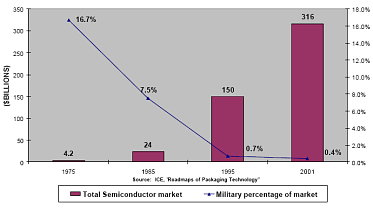
Figure 3.2: The decline of the presence of the military sector in the market of the members elettronici.8
An other interesting prospect of the situation, is supplied from the successive figure.
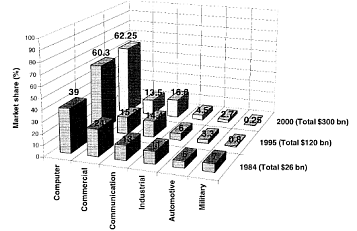
Figure 3.3: Historical projection of the change in the world-wide market of the devices you to semiconduttore.9
To ulterior new evidence of the insufficient presence of the military sector in the market of the semiconductors, in 2001, the situation was that one shown from the following figure.
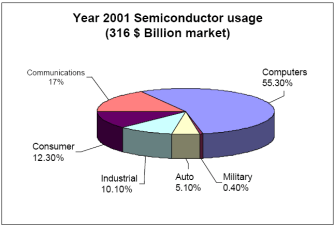
Figure 3.4: The use of the semiconductor devices you in the various segments of market in the 2001.10
The field trades them of the telecommunicationses and the industry of the computers, therefore, is currently dominating of the market of the devices technological you.
In the time, therefore, the market of the electronic members, for military scopes, it had become less and less attractive, while the costs of research & development for new generations of dispositi to you technological grew; the only way, therefore, in order to realize a return on such investments, was to serve the mass market.
The problem ulteriorly was aggravated from the fact that devices specific you for the military sector had to be produced following specific adapted (MIL-SPEC) that of it they assured the reliability and the performances: this, unavoidablly, made to grow the set-up costs ulteriorly them of production.
Because of this, to the end, the 12 suppliers of the market of military componentistica, between which Motorola, Intel and Philips, in first years ninety, they decided to abandon such type of produzione11.
On the other hand, already in years eighty, to the end of the Cold War, with the tendency to reduce expenses to military scope, in the United States new called politics Acquisition Reform came in existence put one, with which it was settled down to prefer dispositive answering you to detailed lists closely trades them to those constructed specific soldiers second.
Such initiative, came then formalized from the Secretary of the Defense William Perry who, the 29 june 1994, signed policy “the Specifications and standards - To new way of doing business”, in which openly promuoveva the use of dispositi is assigned to you to you at the market trades them in place of those constructed second dictates MIL-SPEC to me.
In last analysis, this combined tendency of the producers to the abandonment of at the market military service, for the perseguimento of the economic profit, and the flexibility of the producers of paramilitary weapon systems and to the use of members trades them, because is forced, is for reasons of economic convenience has completely exausted the control of the industries of the defense on the market of the semiconductors and, consequently, on the own suppliers of dispositi to you electronic.
Such phenomenon, with to the smaller performances in terms of reliability of the devices not constructed to you on detailed lists MIL-SPEC, has carried these industries to having to face obsolescence problems is in the gathering phase, because of the long times of planning and realization, than, above all, in the phase of support of the produced systems and uses you.
Other reason for which he is indispensable to place the attention on the merceologici fields does not trade them, com'č also pointed out in the previous citation, draft from “Aging military electronics: what can the Pentagon I give? ”, it is the length of the cycle of life of the produced systems and uses you in such fields.
E' exactly this one of the reasons for which, the paramilitary support of weapon systems, avionici or are that one mainly hit rebelling of obsolescence problems: the cycle of life of the weapon system, as an example, has endured a remarkable streching in the time, which had to along acquisition process; examples of said how much in the previous proposizione are brought back in the successive figure, that it puts in extension like, the cycle of life previewed for some weapon systems, come extended in the time. 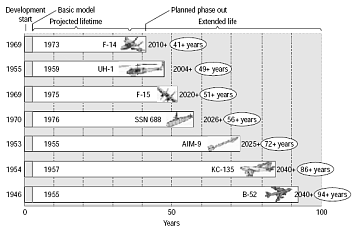
Figure 3.5: Extension of the life cycle of some weapon systems beyond the term previewed for the dismissione12
Because of this, and of already along cycle of life of the sopramenzionati systems, is found to having to us to face rebelling of the obsolescence more times during the operating phase of the products of this kind. Such tendency, considering said how much on the speed with which, more and more with passing of the years, they come introduced new generations of members on the market, has caught up by now breathtaking and little sostenibili rhythms from the economic point of view. A qualitative example of such vicissitudini is shown in the brought back figure under, in which it comes illustrated like, in single ten years, the participations of upgrade necessary to the support of a complex system, with a cycle of life estimated in thirty years, are triple to you.
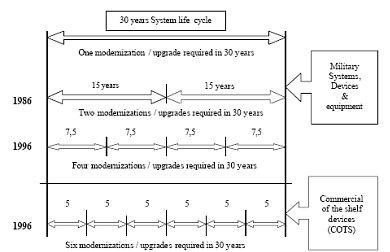
Figure 3.6: Example of as remarkable problems of obsolescence rebel more and more frequently during the cycle of life of complex systems with passing of the years.13
An other aspect of remarkable importance and that it interests above all arranges complexes, regards rebelling of the obsolescence not in the phase of use, but in the same gathering phase. Such phenomenon, more recurrent than how much tasks, depends is from along period of planning that it arranges of this type need, is from the little inclined mentality to the proattivo approach to the obsolescence and that, only in the last years, it is enduring a sure change: the policy that it is being attempted to make to pass, making them to become ruotine in the modus operandi, in fact, they preview the effort towards the forecast of the obsolescence end from the progettuale phase.
- 3: W. T. Hartshorn, Obsolescence management process as a best practice, Obsolete parts leverage team roadshow.
- 4: Northrop Grumman, Best practice: component obsolescence management, Defensive Systems Division-Rolling Meadows, IL, 29 giugno 2001.
- 5: F. Haub, Managing materiel shortages the USN way, International defence review-extra, 01 settembre 1997.
- 6: Hamilton e Chin, Aging military electronics: what can the Pentagon do?, National Defence, marzo 2001.
- 7: L. Condra supportato da D. Followell, G. Houchens, J. Jenks, M. Koehler, Z. Porter, Minimizing the effects of electronic component obsolescence, Electronic products Boeing Information Space & Defence System, maggio 1998.
- 8: W. T. Hartshorn, Obsolescence management process as a best practice, Obsolete parts leverage team roadshow.
- 9: W. Lloyd, C. Condra, A. Amir Anissipur, D. Tennis Mayfield, G. Michael Peatch, Electronic components obsolescence, IEEE Transactions on components, packaging and manufacturing technology - Parte A, volume 20, n° 3, settembre 1997.
- 10: W.T.Hartshorn, Obsolescence management process as a best practice, Obsolete parts leverage team roadshow.
- 11: M. B. Wright, D. Humphirey, F. P. McCluskey, Uprating electronic component for use outside their temperature specification limits, IEEE Transactions on components, packaging and manufacturing technology, Part A, volume 20, n°2,giugno 1997.
- 12: R. C. Stogdill, Dealing with obsolete parts, IEEE Design Test Comput., volume 16, aprile-giugno 1999.
- 13: W.T.Hartshorn, Obsolescence management process as a best practice, Obsolete parts leverage team roadshow.







